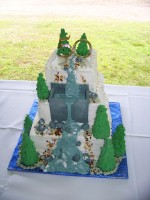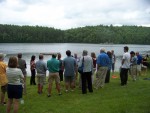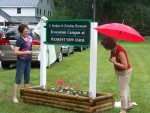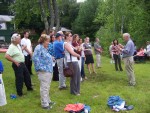Continuous long-term studies are rare in ecosystem science. On 1 June 1963 the first water sample was collected at Hubbard Brook (HBR) and the Hubbard Brook Ecosystem Study was officially born--an event commemorated in July 2013 with a 50th anniversary symposium and celebration.
The story of HBR as a Long Term Ecological Research site is quite interesting, if a little confusing to many people. The LTER site is located within the Hubbard Brook Experimental Forest, which was established by the U.S. Forest Service in 1955 as an experimental facility to quantify the effects of forest management on water supplies in the Northeast. Robert S. Pierce of the U.S. Forest Service reached out to Gene E. Likens, F. Herbert Bormann, and Noye M. Johnson, then at Dartmouth College, in the early 1960s to encourage their cooperation in education and research activities at Hubbard Brook.
This collaboration led to the establishment of the Hubbard Brook Ecosystem Study to examine the response of small forest watershed ecosystems to natural and human-caused disturbances. Following the establishment of the Hubbard Brook Ecosystem Study, Hubbard Brook was designated a Biosphere Reserve under UNESCO’s Man and the Biosphere Programme (1976) and became part of the National Science Foundation’s Long Term Ecological Research (LTER) network (in 1988).
In 1993, the Hubbard Brook Research Foundation was established as a “friends group” to support education, outreach, and research logistics at Hubbard Brook. HBRF activities have included the Science Links program through which Hubbard Brook and other regional science is synthesized and translated to inform environmental policy and management.
The 50th anniversary was marked by a day-long celebration looking back on the people and science of Hubbard Brook and looking forward to the critical issues and challenges for the Northern Forest and the global environment anticipated over the next decades. The celebration included keynote lectures by Gene Likens of the Cary Institute of Ecosystem Studies; Fred Krupp, President of the Environmental Defense Fund; and Ann Bartuska, U.S. Department of Agriculture’s Deputy Undersecretary for Research, Education and Economics. The program also involved five forward-thinking “Herb Talks” (modeled after “Ted Talks” and named for the late Herb Bormann) by John Battles, University of California, Berkeley; Charles Driscoll, Syracuse University; Nicholas Rodenhouse, Wellesley College; Lindsey Rustad, US Forest Service; and Kathy Fallon Lambert, Harvard Forest.
The celebration was attended by more than 250 researchers, students, Hubbard Brook alumni, and friends, and included a dedication of the Pleasant View Farm dormitory and campus to Herb and Christine Bormann, a “Founders’ dinner” that included multiple generations from the four founding families, and many good conversations, discussions, and memories.
In the 50 years since its formation Hubbard Brook has been a site of transformative science that has had substantial impact on our understanding ecological and ecosystem processes. Acid rain was first reported in North America at Hubbard Brook by Gene Likens and colleagues. Detailed studies that followed first documented the effects of acid rain on the Northern Forest and then the forest’s recovery in response to U.S. air quality management programs.
Research on forest cutting and management has been a hallmark of the Hubbard Brook Ecosystem Study. Probably the most well-known experiment conducted at the site was the de-vegetation of a watershed for three years and the subsequent study of the role of forest vegetation in controlling hydrology and nutrient losses. Hubbard Brook is also the site of one of the longest continuous studies of the dynamics of bird populations, through the research of Richard Holmes and colleagues.

 Enlarge this image
Enlarge this image


